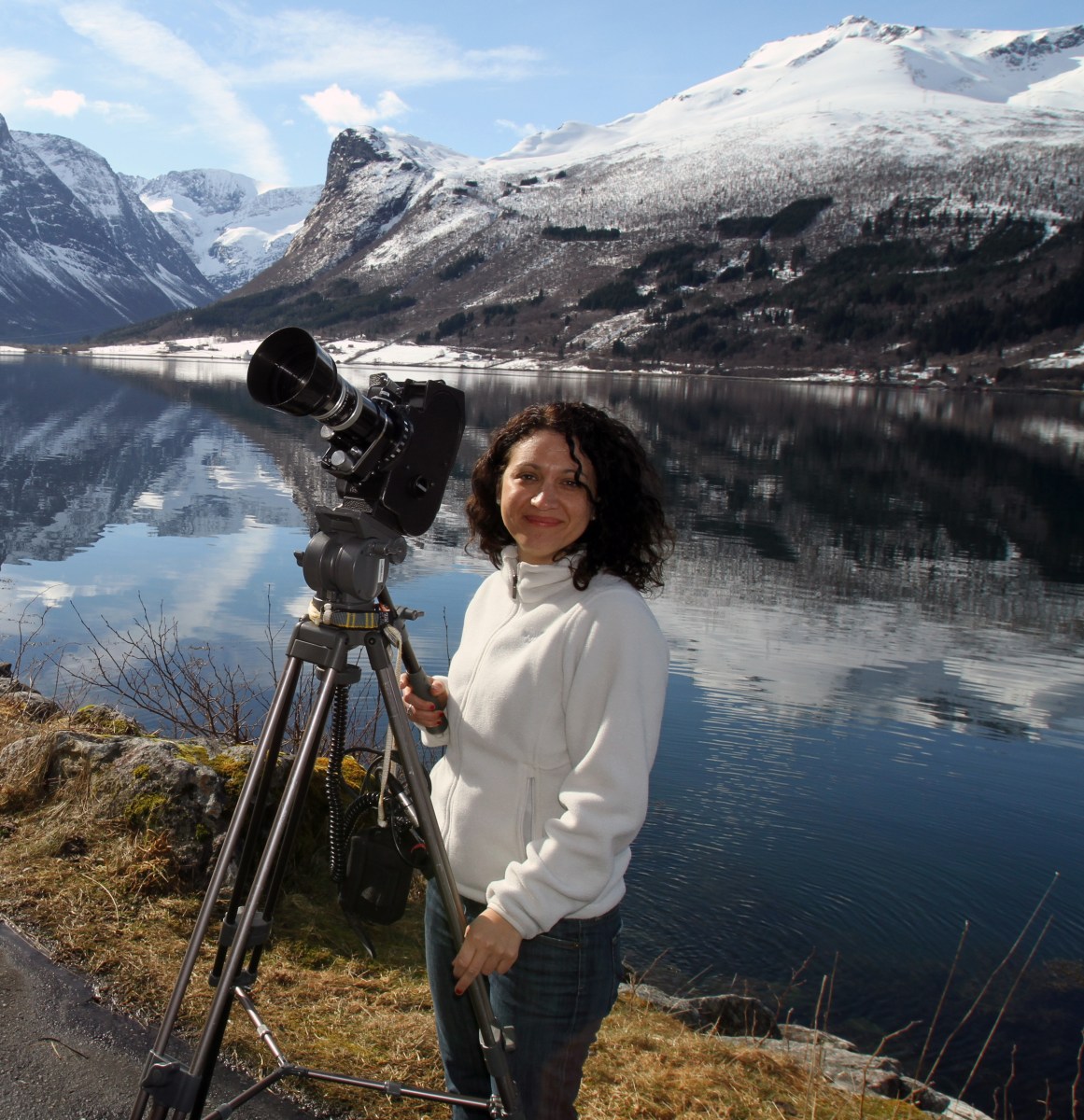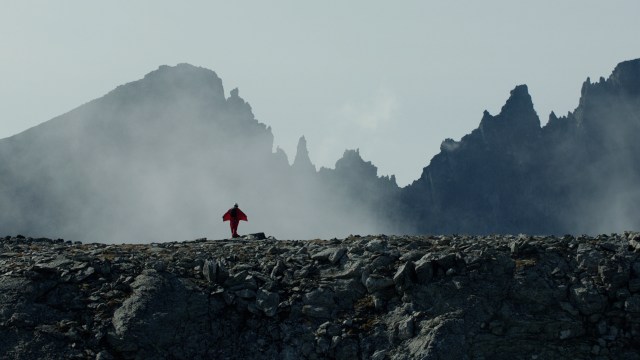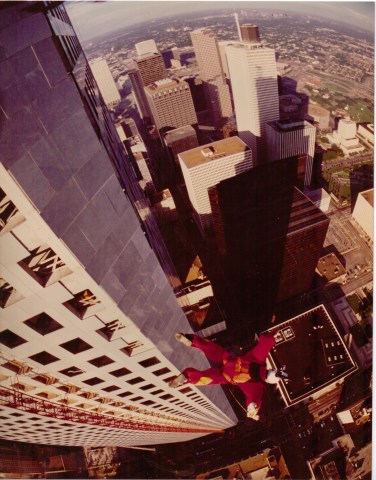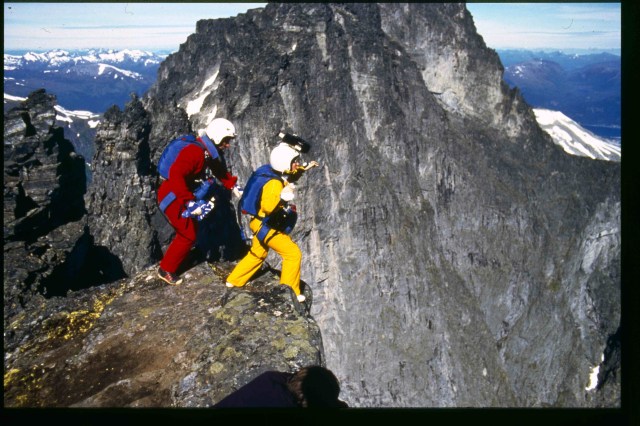It’s only fitting that in the summer, when movies are all about thrills and special effects, the new documentary Sunshine Superman should be released. The engrossing film about the late Carl Boenish, the founder of BASE jumping, and his wife and partner Jean, is all about capturing the stunning visuals these jumpers were able to see during their leaps. Full jumps are shown in the documentary, giving you the intimate (sometimes terrifying) feeling of what these thrill seekers see on their way down, and what propels them to climb mountains and buildings and jump off. First time documentarian Marah Strauch directed this very cinematic documentary, in theaters starting this week, which is receiving critical praise as one of the best documentaries of the year…and one best experienced on the big screen. We spoke about bringing the story of the Boenishs to the public and her unexpected personal connection to the sport.
Lesley Coffin (TMS): Were you personally interested in BASE jumping as an activity before beginning work on the documentary?
Marah Strauch: I’m interesting in BASE jumping more as a filmmaker than as an activity for myself. But I am interested in it and I find watching BASE jumping and getting to know jumpers to be fascinating.
TMS: How did you learn about Carl and Jean Boenish?
Strauch: My uncle was a BASE jumper and aerial cinematographer. He died in an automobile accident, but left behind some amazing footage, including these VHS tapes with footage of Carl, along with some of Carl’s own early shorts. And I just became really interested in the footage and tracked Jean Boenish down and started speaking to her about her life and their life.
TMS: Did you know about the footage while your uncle was alive?
Stauch: I had no idea. I wasn’t aware of any of it.
TMS: What made you want to turn his footage into a documentary?
Strauch: When I first found the film, I wasn’t really even a filmmaker. I had a background in visual art and had worked as an editor, which was a helpful background to have for a project like this. But it wasn’t even apparent to me at first that what I had could be a feature, I just thought if could be an interesting story. Doing this films felt kind of like having an educating in filmmaking while I was doing this and ending up becoming a filmmaker.
TMS: In terms of how the film is laid out, can you explain the kind of footage you used?
Strauch: It was a significant amount of archival footage I tracked down and lots of interviews. We tried to avoid having too many talking head sequences, so we got around that by including some subtle reenactments. Carl was an amazing aerial cinematographer and great at shooting BASE jumping, but he didn’t film too many private, intimate moments, and we felt we had to have some of those moments in the film using reenactments, so we could have a better sense of him. And Carl had a lot of audio as well, so in addition to the 16mm footage we which was a big find, there were hours and hours of audio interviews and lectures he’d done speaking about base jumping and his philosophies about life. And also conversations with people who were telling him about their experience base jumping, which as someone who invented that activity, must have been pretty exciting to hear.
TMS: How did you get in touch with Jean?
Strauch: When I found Jean, all I had were the VHS tapes, and I told her “I think the guy in these tapes is your husband.” And the story has never really been written so I really had to piece everything together. I got her number through a friend who had to contact someone else to get it. And I also had to put all these people back in touch again. Jean was open to the project, but I did have to give her a number of proposals before we went forward. But she’s been a great partner.
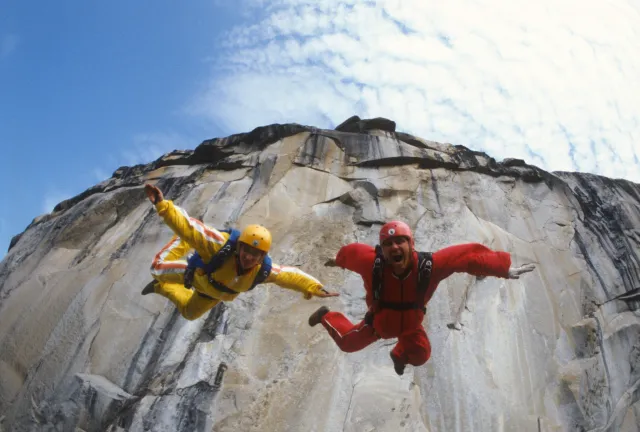
TMS: Did she provide the audio and 16mm?
Strauch: Yeah. The interesting thing about Carl was that he left behind an incredible studio where he put together all these films, editing them. So for example, the moviola in the film is his original moviola. And everything that looks like set design at the beginning of the film is his house. So it was a great advantage to me that his studio was there and had remained virtually untouched, and that I was given access to it by Jean. He was an engineer so he made going through all his things very easy, or as easy as it could be. He was really very organized so all his tapes were marked.
TMS: How important was it to put Jean’s role in establishing the sport into perspective in this documentary?
Strauch: It was really important because it really took meeting Jean for all these things to come together in Carl’s life. And for her, it was the something. They really needed each other to have this moment. They started a sport together and it really was done as a team. He was more the bubbly part of the duo and the public face, but what Jean provided was knowing how to work with bureaucracy and figuring how to get around rules and restrictions that Carl would have never been able to. They needed each other. And I just wanted to make sure she was included, because I don’t think people ever got to see her, even though she made a big impact. Her story has just been kind of forgotten.
TMS: Was it a challenge to balance the thrilling part of the story with the tragic circumstances of how Carl died?
Strauch: It was difficult, because Carl was only the second fatality in the sport’s history at the time. At that time people were saying “oh, base jumping is so dangerous,” but there weren’t nearly the number of fatalities we would eventually see. It was shocking when Carl died because he was so experienced and had done so many jumps. But for me personally, I didn’t get hung up on how dangerous the sport was, because i was so caught up in the exhilaration of the sport. There are a lot of things which are dangerous in life.
TMS: Have you gone BASE jumping?
Strauch: No. It takes a lot of skill to go base jumping, which not a lot of people don’t realize. You have to have experience skydiving, and be considered an expert in that before BASE jumping. And it is not my drive to be a sky diver or BASE jumper. My drive is to tell interesting stories about interesting people, and thrill seekers tend to be interesting people. People willing to go to the edge and jump off are pretty much the most interesting people I could hope to meet. So for me, I was more excited about learning their stories.
TMS: I was really impressed that in a documentary, you were able to get as much popular music as you have in the film, which isn’t cheap. Why make that kind of investment?
Strauch: I really felt that the tone of the film had to have an analog feeling of pop music of the 60s and 70s. We used some more contemporary music, like Belle and Sebastian, but even that has a nostalgic sensibility. It really sets the tone of the movie. I love the way Wes Anderson uses soundtracks and I felt that these real life people were strangely similar to some of his characters. But, I also used Wagner so I had a pretty wide range of music I was pulling from. But in terms of licensing, that was really hard. My producer Eric Bruggemann was in charge of that and he was just a magician in terms of getting music I never thought it would be possible to get. I found all the tracks I wanted and he got them for me, despite the budgetary concerns, because all along I knew we needed that type of music in the movie. I wanted the film to feel like a cinematic experience that didn’t just feel like any other documentary. I wanted it to be immersive, and a soundtrack that evokes the time is a way to do that.
TMS: Using so much archival material, how did you deal older footage that might already show signs of deterioration?
Strauch: Some of the material was never going to get better than what we had. The only footage we have of Carl speaking in this kind of funny, natural way to the camera we had to use, and its even in the trailer, but it was never going to look good because it was VHS footage. So we allowed VHS footage to look like VHS footage and didn’t clean it up. But we had an amazing wealth of 16mm footage which was really well preserved. But we also had a great colorist working on the film, who did an amazing job fixing the fading color. So we did restoration work on the footage when it would actually make a difference. But with VHS, there isn’t much you can do.
TMS: Using reenactments is always a topic of debate in documentaries. Did you establish rules about when you would use them?
Strauch: My rule was, whenever we could use archival footage, we did. But when there was a time when we wanted to tell an intimate or emotional part of the story and we didn’t have any footage that existed, we recreated it. Because we didn’t want to just have talking heads and again, we want this to be a cinematic experience. And we tried to keep the recreations subtle and in the space of re-imagining whenever possible. I think reenactments have gotten a bad name, but I’m a fan when they are done well. Documentaries should be a cinematic experience and documentarians shouldn’t feel limited.
TMS: Are you already looking for another subject or person to document?
Strauch: I’m open to making more documentaries, but I’m also considering narrative films as well. I think directors can go back and forth. I mean look at the career of Werner Herzog, James Marsh, or Sarah Polley. Its storytelling, and I’d be excited to tell a fiction story because I’d be able to make things up.
Lesley Coffin is a New York transplant from the midwest. She is the New York-based writer/podcast editor for Filmoria and film contributor at The Interrobang. When not doing that, she’s writing books on classic Hollywood, including Lew Ayres: Hollywood’s Conscientious Objector and her new book Hitchcock’s Stars: Alfred Hitchcock and the Hollywood Studio System.
—Please make note of The Mary Sue’s general comment policy.—
Do you follow The Mary Sue on Twitter, Facebook, Tumblr, Pinterest, & Google +?



